
The necropolis of Sheikh Abd el-Qurna is located on the West Bank at Thebes in Upper Egypt. It is part of the archaeological area of Deir el-Bahari.
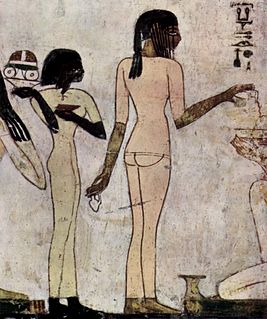
The Theban Tomb TT100 is located in Sheikh Abd el-Qurna, part of the Theban Necropolis, on the west bank of the Nile, opposite to Luxor. It is the mortuary chapel of the Ancient Egyptian vizier Rekhmire. There is no burial chamber next to this chapel. The vizier's tomb is elsewhere, perhaps even in the Valley of the Kings.
The Theban Tomb TT99 is located in Sheikh Abd el-Qurna. It forms part of the Theban Necropolis, situated on the west bank of the Nile opposite Luxor. The sepulchre is the burial place of the Ancient Egyptian noble, Senneferi. It has been worked on by an expedition from the University of Cambridge since 1992.

The Theban Tomb TT89 is located in Sheikh Abd el-Qurna, part of the Theban Necropolis, on the west bank of the Nile, opposite to Luxor. It is the burial place of the Ancient Egyptian Amenmose, who was Steward in the Southern City during the reign of Amenhotep III, in the 18th dynasty.
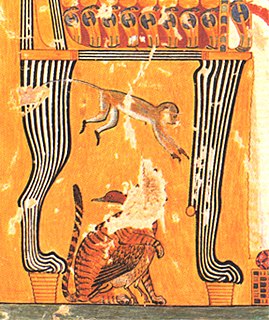
The Theban Tomb TT120 is located in Sheikh Abd el-Qurna. It forms part of the Theban Necropolis, situated on the west bank of the Nile opposite Luxor. The tomb is the burial place of the Ancient Egyptian official, Anen who was the brother of Queen Tiye, and became Chancellor of Lower Egypt, Second Prophet of Amun, sem-priest of Heliopolis, and Divine Father under the reign of the Amenhotep III. The tomb is currently being excavated by Lyla Pinch Brock.
Tomb C.3 is an Ancient Egyptian sepulchre in Thebes, Upper Egypt. It is located in Sheikh Abd el-Qurna, part of the Theban Necropolis on the west bank of the Nile opposite Luxor.
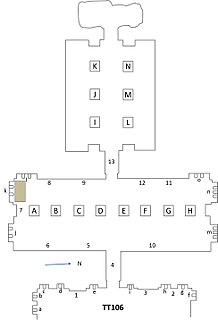
The Theban Tomb TT106 is located in Sheikh Abd el-Qurna. It forms part of the Theban Necropolis, situated on the west bank of the Nile opposite Luxor. The tomb is the burial place of the Ancient Egyptian noble and Vizier, Paser.
The Ancient Egyptian noble Amenmose lived in Thebes during the reigns of Amenhotep III. He was buried in a tomb in Sheikh Abd el-Qurna, part of the Theban Necropolis.
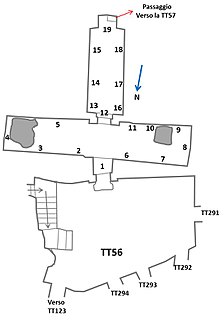
The Theban Tomb TT56 is located in Sheikh Abd el-Qurna. It forms part of the Theban Necropolis, situated on the west bank of the Nile opposite Luxor. The tomb is the burial place of the Ancient Egyptian official, Userhat who was the Royal Scribe, Child of the Royal Nursery, during the 18th dynasty king Amenhotep II, and his wife Mutnefret. TT56 is one of the best preserved Theban nobility tombs from Western Thebes and its paintings boast many vivid and brightly painted scenes depicting the deceased Userhat and Mutnefret receiving gifts and presents in the afterlife.
The Theban Tomb TT42 is located in Sheikh Abd el-Qurna, part of the Theban Necropolis, on the west bank of the Nile, opposite to Luxor. It is the burial place of the Ancient Egyptian Amenmose, who title was Captain of Troops, Eye of the King in Retenu, he is buried alongside his wife, Henuttaui.
The Theban Tomb TT67 is located in Sheikh Abd el-Qurna. It forms part of the Theban Necropolis, situated on the west bank of the Nile opposite Luxor. The tomb is the burial place of the Ancient Egyptian official, Hapuseneb, who was High Priest of Amun during the New Kingdom reign of Hatshepsut.
The Theban Tomb TT23 is located in Sheikh Abd el-Qurna, part of the Theban Necropolis, on the west bank of the Nile, opposite to Luxor. It is the burial place of the Ancient Egyptian official, Tjay or Thay called To who was a royal scribe of the dispatches of the Lord of the Two Lands, during the 19th Dynasty. Thay served during the reign of Merenptah.
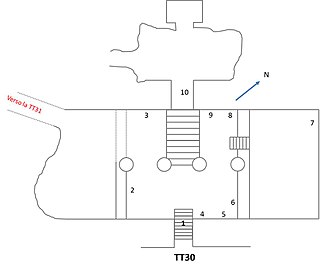
The Theban Tomb TT30 is located in Sheikh Abd el-Qurna, part of the Theban Necropolis, on the west bank of the Nile, opposite to Luxor. It is the burial place of the Ancient Egyptian official, Khonsumose.
The Theban Tomb TT44 is located in Sheikh Abd el-Qurna. It forms part of the Theban Necropolis, on the west bank of the Nile opposite Luxor. The tomb is the burial place of the Ancient Egyptian Amenemhab, whose title was wab-priest in front of Amun. He dates to the Ramesside Period.
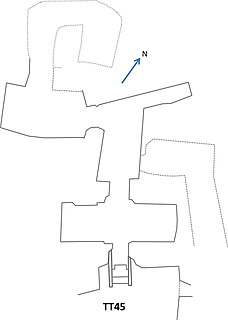
The Theban Tomb TT45 is located in Sheikh Abd el-Qurna, part of the Theban Necropolis, on the west bank of the Nile, opposite modern Luxor.

The Theban Tomb TT171 is located in Sheikh Abd el-Qurna, part of the Theban Necropolis, on the west bank of the Nile, opposite to Luxor.
The Theban Tomb TT61 is located in Sheikh Abd el-Qurna. It forms part of the Theban Necropolis, situated on the west bank of the Nile opposite to Luxor.

The Theban Tomb TT127 is located in Sheikh Abd el-Qurna, part of the Theban Necropolis, on the west bank of the Nile, opposite to Luxor.

The Theban Tomb TT53 is located in Sheikh Abd el-Qurna. It forms part of the Theban Necropolis, situated on the west bank of the Nile opposite Luxor. The tomb is the burial place of the Ancient Egyptian official Amenemhet, who was an administrator in the Amun Temple during the reign of Thutmose III.
The Theban Tomb C.14 is an Ancient Egyptian tomb in Thebes, Upper Egypt. It is located in Sheikh Abd el-Qurna, part of the Theban Necropolis on the west bank of the Nile opposite Luxor. The tomb likely dates to the Twenty-sixth dynasty of Egypt.
Scientists from the National University of La Plata will explore the tomb of Amenmose, more than 3,500 years old.
A team of researchers from the Faculty of Humanities and Educational Sciences of the National University of La Plata obtained the concession of the Egyptian Ministry of Antiquities to explore the tomb of Amenmose (TT 318) located in Sheikh Abd el-Qurna, Luxor, Egypt: Dr. Andrea Zingarelli, director of the project and teacher at the Faculty of Humanities, said that “this tomb is more than 3,500 years old and its paintings and reliefs were never studied or published. They also need to be preserved so that they do not get lost forever. ”During the month of January this year, a group of scientists from the UNLP, the National University of Córdoba and the University of Buenos Aires traveled to Egypt for the purpose of Start a new research project on the ancient Pharaonic culture.
The team, led by Zingarelli, remained in the cities of Cairo and Luxor for 40 days visiting the archeological sites. Upon returning, they presented a project to the Ministry of Antiquities, which was approved in April. The scientist said that "the tomb carved into the rock is decorated with magnificent paintings and reliefs that need to be preserved so that they are not lost forever. These valuable pictorial and written records of human history over 3500 years old also need to be studied and published to be known throughout the world. "The first campaign will take place from January 2020 and are in search of financing. Zingarelli clarified that “in order to carry out this expedition we need contributions that allow us to finance the campaign in Egypt.
Great discoveries await us and we will develop research that will contribute knowledge to the history of mankind and for scientific dissemination. We think it is important that we are the first researchers to study this tomb in Argentina and we hope to have the necessary support to carry it out. ”This new Argentine mission in Egypt is entitled“ Amenmose Project ”and the conservation and study of the tomb of Amenmose (TT) is proposed. 318) located in Sheikh Abd el-Qurna, Luxor, Egypt. Amenmose was a stonemason of the Amun necropolis who lived during the reigns of Hathsepsut and Thutmose III, around the years 1479-1458 BC. Its tomb is among the numerous funeral chapels of high and medium dignitaries unevenly distributed along the western hills of ancient Thebes.
This set of tombs are called private tombs or tombs of nobles and constitute one of the greatest sources of information of ancient Egyptian society.The work aims to contribute to the conservation of the monument while developing various interdisciplinary lines of research with base in Egyptology, history, conservation and archeology.
The project is based in the Research Institute in Humanities and Social Sciences (UNLP-CONICET) and the UNLP research team is composed of Andrea Zingarelli, María Belén Castro, Yesica Leguizamon, Pablo Martín Rosell, Leila Salem, María Martha Sarmiento and Myriam Hara. In addition, advanced students and graduates of the UNLP will participate in the project. Other researchers from the CONICET of the UBA, the UNC and the UFTM (Federal University of Triângulo Mineiro) are also part of the team.













